Benin and Ghana (Private) Photography Tour Report 2024
3 February 2024







































































































































A male Gambada dancer covers his face in Kaolin (image by Inger Vandyke)

Aerial view of the vast salt pans in Elmina, Ghana (image by Inger Vandyke)

Ashanti women dressed in red and black to attend the Saturday ceremony of an Ashanti Funeral (image by Inger Vandyke)

Young guys goofing off in front of the old mosque in Porto Novo (image by Inger Vandyke)

Erico, one of the most famous carvers of Fantasy Coffins in Ghana (image by Inger Vandyke)

King Suorwu of Ghana's Krobo people (image by Inger Vandyke)

The main stair case in St George's Castle, Elmina. It was one of the key slaving castles in West Africa (image by Inger Vandyke)

Portrait of a beautiful Dipo girl of Ghana's Krobo people in Somanya (image by Inger Vandyke)

Enjoying the modern Benin art of Sess Essoh at a gallery of modern art in Abomey (image by Inger Vandyke)

Portrait of Miriam (image by Inger Vandyke)

A mother cradles her young baby in a Beninese fishing community (image by Inger Vandyke)

Portrait of a Koku dancer covered in Kaolin powder and yellow palm oil - the symbols of the Koku divinity (image by Inger Vandyke)

Local fishermen mending nets on the side of Elmina's harbour (image by Inger Vandyke)

The drummers of an Ashanti King (image by Inger Vandyke)

The idols of Gambada, the voodoo ceremony of love (image by Inger Vandyke)

An older Dipo initiate laughing (image by Inger Vandyke)

The colourful fishing community of Elmina in Ghana (image by Inger Vandyke)

A privileged visit to a maker of the wooden masks used in Benin's Guelede ceremonies (image by Inger Vandyke)

The Mask Maker's wife - a privileged invitation to a quiet moment in Benin (image by Inger Vandyke)

Kayaks waiting for action on a beach at the side of the Volta River in Ghana (image by Inger Vandyke)

The islands of Lake Volta, the largest artificial reservoir in the world (image by Inger Vandyke)

Koku is one of the wildest and most fascinating ceremonies we see on our tour (image by Inger Vandyke)

At the water's edge, the community of Ganvie with its fish farms spreading into Lake Nokoue (image by Inger Vandyke)

Older Dipo initiates hugging each other in the palace of King Suorwu of Somanya, Ghana (image by Inger Vandyke)

A traditional house in Ganvie on Lake Nokoue (image by Inger Vandyke)

Celebrating Benin's incredible relationship with twins, we visited the home of a priestess whose role is to look after twin dolls in Benin (image by Inger Vandyke)

Kpodji Guegue stilt dancer entering the ceremony (image by Inger Vandyke)

Portrait of a Shango elder (image by Inger Vandyke)

A Koku devotee covered in Kaolin and yellow palm oil, the symbols of the Voodoo divinity of strength and power (image by Inger Vandyke)

One of the skulls used at the ceremony of Shango, the Voodoo judiciary represented by thunder and lightning (image by Inger Vandyke)

Portrait of Adra. She has spent her life making the fabric paint that adorns Adinkra, one of the traditional cloths of Ghana (image by Inger Vandyke)

The beautiful beaded decorations adorning the hips of Krobo girls as they pass through Dipo, one of the most significant initiation rituals of Africa (image by Inger Vandyke)

Adinkra cloth for sale in Ghana (image by Inger Vandyke)

An Egungun emerging from a sacred forest with his guardian (image by Inger Vandyke)

Krobo women sing and dance to prepare young girls for a Dipo ceremony (image by Inger Vandyke)

Once a young Krobo girl passes through Dipo she wears yellow beads and works to guide younger girls through the initiation process (image by Inger Vandyke)

A black and white portrait of two young Krobo girls preparing for Dipo (image by Inger Vandyke)

Kpodji Guegue stilt dancer taking a break (image by Inger Vandyke)

Breathing fire at a Zangbeto ceremony (image by Inger Vandyke)

A twins priestess at home (image by Inger Vandyke)

West African Frankincense wafts around after an Ashanti chief uses burning incense to prepare for the arrival of Ashanti royalty (image by Inger Vandyke)

Athletic Koku dancers twirl with their amazing grass skirts (image by Inger Vandyke)

An excited little girl comes out to greet us as we wandered around her village in Benin (image by Inger Vandyke)

Kpodji Guegue entertainer in Benin (image by Inger Vandyke)

Adra making Adinkra cloth paint in her workshop (image by Inger Vandyke)

Stabbing while jumping is akin to rubbing your belly while tapping your head - difficult! But not so difficult for talented Koku dancers in Benin (image by Inger Vandyke)

The amazing facial scarification of an elderly Holi lady in remote Benin (image by Inger Vandyke)

Ganvie in the mist and fog of a harmattan. The distant city of Cotonou is on the horizon (image by Inger Vandyke)

Aerial view of Cape Coast Castle, its fishing pirogues and fortified beach (image by Inger Vandyke)

A Tofinu man smiling as he poles his canoe through Ganvie (image by Inger Vandyke)

An Ashanti Chief arrives at a funeral under the shade of a customary umbrella (image by Inger Vandyke)

Portrait of a twins priestess in the doorway of her home in remote Benin (image by Inger Vandyke)

Aerial of Ghanaian salt workers raking salt in the pans of Elmina (image by Inger Vandyke)

The golden beads of an older Dipo initiate in the Krobo culture of Benin (image by Inger Vandyke)

The next King of Benin's Holi people (image by Inger Vandyke)

Queueing for fresh drinking water in Ganvie (image by Inger Vandyke)

Guelede is all about all things women and children. Here a young child looks up at a Guelede masked dancer in admiration (image by Inger Vandyke)

Beninese children start dancing even before they can walk. They learn their moves from their mothers (image by Inger Vandyke)

A gathering of Shango priests at a judicial ceremony devoted to handing down a verdict in voodoo law (image by Inger Vandyke)

The memorial to the slaves who died in the Trans-Atlantic at St George's Castle in Elmina, Ghana (image by Inger Vandyke)

A group of guests attending an Ashanti funeral (image by Inger Vandyke)

Sunrise through the coconut palms in Elmina (image by Inger Vandyke)

Beware of Egunguns arriving at sunset! (image by Inger Vandyke)

An elderly trainer of young Voodoo adepts in remote Benin (image by Inger Vandyke)

Ink block image of the children kept as slaves in Ghana (image by Inger Vandyke)

Art detail adorning the walls of Agonglo Palace in Abomey (image by Inger Vandyke)

Ashanti chiefs presiding over an Ashanti funeral (image by Inger Vandyke)

A Zangbeto official at our dusk Zangbeto ceremony (image by Inger Vandyke)

Kpodji Guegue stilt dancers taking a break with their ghoulish guardian (image by Inger Vandyke)

Guelede is always entertaining to local children (image by Inger Vandyke)

Aerial view of Ganvie's fish farms in Lake Nokoue, Benin (image by Inger Vandyke)

A young girl eats her breakfast at the palace of King Suorwu in Somanya, Ghana (image by Inger Vandyke)

Tofinu children grow and thrive on the waters of Lake Nokoue in Benin (image by Inger Vandyke)

A young girl watches a ceremony of voodoo adepts in remote Benin (image by Inger Vandyke)

We were granted a private audience with one of the Ashanti kings during our tour in Ghana (image by Inger Vandyke)

Portrait of a Guelede fire dancer (image by Inger Vandyke)

Drone view of St George's Castle in Elmina at sunrise (image by Inger Vandyke)

The entrance to the dungeon of St George's Castle where slaves were kept in Elmina (image by Inger Vandyke)

Egungun dancing is hard work, often calling for a rest! (image by Inger Vandyke)

A spontaneous and unexpected invitation to visit the inside of Porto Novo's old mosque (image by Inger Vandyke)

Stunning Ganvie, the Venice of West Africa, at sunset (image by Inger Vandyke)

An elderly Holi man smoking a cigarette (image by Inger Vandyke)

Portrait of King Lutin Sraman II of Ghana's Ashanti people (image by Inger Vandyke)

Egungun! The living manifestion of the ancestors on earth (image by Inger Vandyke)

Motion blur of an Egungun (image by Inger Vandyke)

Portrait of a young man holding a ceremonial umbrella at an Ashanti funeral (image by Inger Vandyke)

The line of fishing pirogues moored up in Elmina's harbour (image by Inger Vandyke)

Colourful umbrellas shade the fish sellers at the market in Elmina (image by Inger Vandyke)

Our Wild Images group got to create their own Adinkra cloth during our 2024 tour. Here their creations lay drying in the sun (image by Inger Vandyke)

The line up of fishing pirogues at sunrise in Elmina (image by Inger Vandyke)

Portrait of a Guelede Fire Dancer (image by Inger Vandyke)

The sculptures outside a Posuban Shrine in Ghana (image by Inger Vandyke)

A Gambada devotee twirling past sacred idols (image by Inger Vandyke)

The crumbling and beautiful facades of Abomey's Afro-Brazilian quarter (image by Inger Vandyke)

Portrait of a Shango priest (image by Inger Vandyke)

No Food For Lazy Man in Elmina (image by Inger Vandyke)

A Koku dancer pauses to sit on the Koku shrine which will give him the energy to continue with the ceremony (image by Inger Vandyke)

Gambada dancers twirling at the voodoo ceremony of love (image by Inger Vandyke)

Tofinu boys playing in their canoe on the waters of Ganvie (image by Inger Vandyke)

A rare invitation to photograph a Zangbeto chief inside his shrine. Going inside Zangbeto shrines is rarely allowed in Benin so this was a great honour (image by Inger Vandyke)

The wonderful dance of Guelede is a celebration of the feminine divinity in Benin (image by Inger Vandyke)

Coming home after a day of fishing in West Africa (image by Inger Vandyke)

A pretty Tofinu girl poling her canoe through the canals of Ganvie (image by Inger Vandyke)

Portrait of Amelia in the fishing village of Cape Coast, Ghana (image by Inger Vandyke)

Koku (image by Inger Vandyke)

An Ashanti Chief in attendance at our private audience with King Lutin Sraman II of Ghana (image by Inger Vandyke)

A line of elders watch the proceedings at an Ashanti funeral in Kumasi, Ghana (image by Inger Vandyke)

Portrait of a young Tofinu boy joking for photos (image by Inger Vandyke)

An airborn Koku dancer at the annual Voodoo Festival of Benin (image by Inger Vandyke)

Cutting is a part of the Koku ceremony (image by Inger Vandyke)

A beautiful Voodoo Adept (Priestess) arrives at the annual voodoo festival in Benin (image by Inger Vandyke)

Fishing nets hanging to dry at a remote community on the border of Benin and Nigeria (image by Inger Vandyke)

Portrait of an Egungun masked dancer against the backdrop of a sacred forest (image by Inger Vandyke)

Street scenes in the old Afro-Brazilian quarter of Abomey (image by Inger Vandyke)

Oddly pigs wander freely around the fishing villages of West Africa (image by Inger Vandyke)

Excited children at Cove, Benin (image by Inger Vandyke)

Kaolin is used to cover the faces of Gambada dancers in Benin (image by Inger Vandyke)

Portrait of an Ashanti man attending a funeral in Kumasi, Ghana (image by Inger Vandyke)

Ashanti chiefs at a funeral (image by Inger Vandyke)

The hands of an Ashanti funeral guest (image by Inger Vandyke)

An Egungun twirling as he exits the sacred forest (image by Inger Vandyke)

A friendly West African fisherman sitting amongst his nets at Cape Coast (image by Inger Vandyke)

A Guelede Fire Dancer lies on the ground while balancing a bowl of fire on his head! (image by Inger Vandyke)

One of the famous Posuban shrines of Ghana. These shrines are used by the Fante people of Ghana as places of worship (image by Inger Vandyke)

A visit to the hair dressers in Ganvie (image by Inger Vandyke)

Ashanti people are world famous for their wealth in gold (image by Inger Vandyke)

Portrait of a beautiful Voodoo Adept (Priestess) in Benin (image by Inger Vandyke)

Wooden stamps used in the creation of Adinkra. Each one has a special meaning (image by Inger Vandyke)

Split worlds - the daily fish market on one side of the fence and moored pirogues on the other (image by Inger Vandyke)

A Voodoo shaman arrives to officiate at the annual Voodoo Festival in Benin (image by Inger Vandyke)

The palace of King Agonglo, one of the 12 kings of the former Dahomey empire (image by Inger Vandyke)

Strands of beautiful Krobo beads adorn the hips of a Dipo initiate (image by Inger Vandyke)

A young Beninese man wearing a stunning wax cloth shirt at the street art gallery of Cotonou (image by Inger Vandyke)
The vibrant West African countries of Benin and Ghana are perhaps some of the most complex countries, in terms of anthropology, to understand. Each has a harmonious mix of religions and animist beliefs which are followed by a broad spectrum of over 100 different ethnic groups speaking over 80 different languages. The thread that ties them all together and is intertwined with the daily life of millions of West Africans, is Voodoo, a little-understood belief that has been formally classified as a national religion in Benin.
Our 2024 tour to Benin and Ghana explored voodoo beliefs through ceremonies and special events surrounding the annual Voodoo Festival in Benin.
This West African cultural odyssey saw us enjoying encounters with three African kings, learning about the dark history of slavery, witnessing initiation rites and exploring the rapidly changing artisanal fishing communities in both countries.
In western Benin we enjoyed a spill-over of culture from Togo through live Djembe music on the beach, while in the east we learned much about Yoruba cultures through visits to traditional Holi and Mahe villages.
Over in Ghana, we were mesmerised by a private audience with King Nene Suorwu IV of the Krobo people where we witnessed a simulated initiation ritual of young Krobo girls.
Our royal tour continued when we travelled further west to meet with King Nana Lutin Sraman II of the famous Ashanti people in Ghana.
These were just some of the many highlights of our tour!
BENIN
We started our morning after a much-needed sleep-in from late-night arrivals in Cotonou. A late breakfast was followed by a presentation I gave about our tour, what we might expect to see culturally, how to understand West African people and some photography tips on how best to tackle the ceremonies. By the time this ended the heat of the day was at its peak so we all took a small break before going out again in the afternoon.
Since it was our first day in the humid climes of Benin, we took only a short walk from our hotel to visit some nearby street art and the newly erected “Statue of the Amazons”, both of which lay adjacent to Fidjrosse, the main beach of Cotonou. Eventually heat drove us back into the air conditioning of our hotel where we took a short break before going out for dinner of fresh fish on the beach along with cold Beninese beer.
As all of our group had arrived early for the tour to get over the jetlag and time difference after crossing the Atlantic. This meant we had an extra day up our sleeve to go sightseeing so I decided to take us out to the nearby historical city of Ouidah, around an hour’s drive from Cotonou.
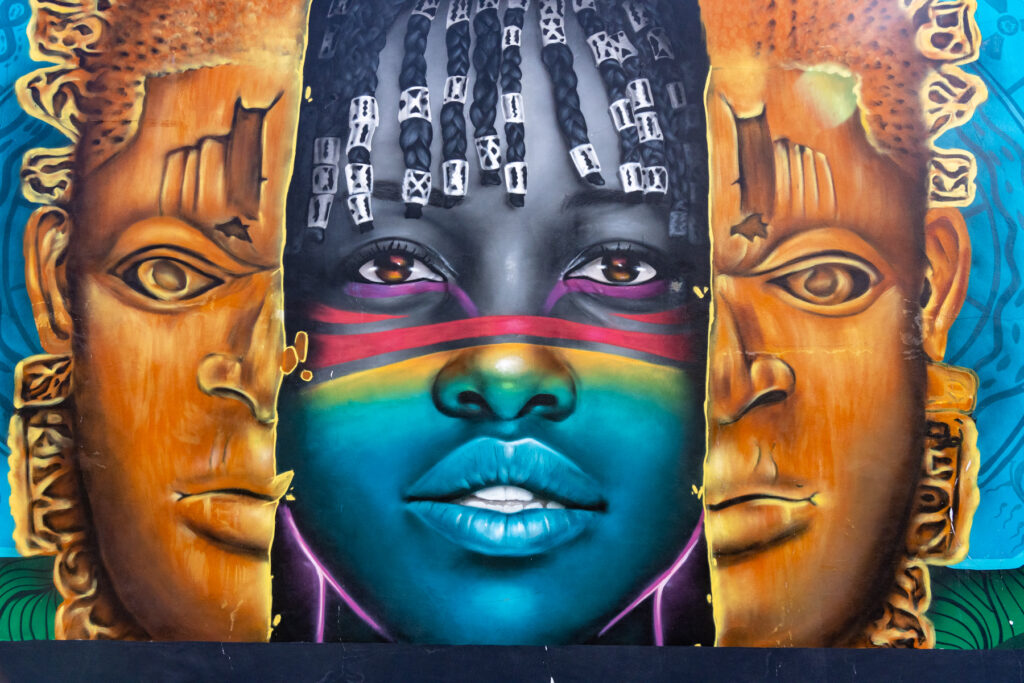
Street art in Cotonou (image by Inger Vandyke)
An Introduction to Voodoo Adepts
When we arrived we discovered a surprise ceremony of local Voodoo Adepts (priestesses) who had gathered outside the python temple to bless the land on which the Voodoo Festival would be held over the next few days. This was our first introduction to Voodoo religion and while it was a little challenging for photography, we managed to get ‘press access’ to the ceremony, allowing us to get a little closer to the singing and dancing of these beautiful women.
After a short time at this surprise event, we walked a short distance to a local restaurant, located in the upper storey of a historical Afro-Brazilian house, for lunch. After cooling off in the shade we visited a local art gallery to do some shopping for local Beninese art before driving out to a village to witness our first real Voodoo ceremony of the trip.
Kpodji Guegue
The Keepers of Secrets in the Realm of the Mystics
We arrived at a tiny village that is home to many voodoo spirits and I planned a surprise ceremony for my group to whet their appetites for the days to follow.
That ceremony was Kpodji Guegue, a rarely seen celebration of stilt dancers and performers who are normally summoned to help someone with advancing in their lives. For example, if a Beninese person is hoping for a job promotion, or to graduate with better grades from school, or be elevated to a head of family position, he/she might consult with the divinity of Kpodji Guegue to grant that wish.
None of us were exactly sure what to expect from this, our first ceremony of the tour. We sat down in the shade of a wall and some palms and waited. After a group of musicians started to perform, the first of the ceremonial dancers arrived from a forest-lined dirt road just a short distance from where we sat. What followed was a wild performance of athletic stilt dancers and masked comedians who jumped and twirled to the wild music in front of us for almost the next two hours! It was our first time witnessing the manifestation of a voodoo divinity and the sheer energy of it all left us enthralled.
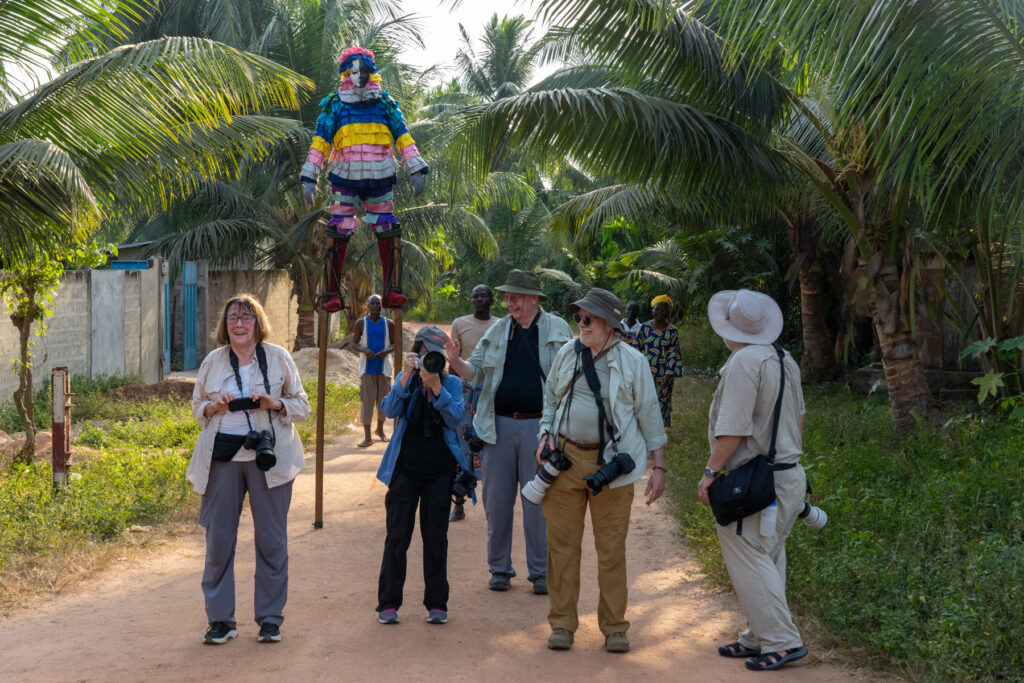
A Kpodji Guegue stilt dancer sneaks up behind our group during a ceremony (image by Inger Vandyke)
Towards the end, I wondered if more dancers were coming so I wandered down to the entrance where we had seen them coming out. This prompted a surprise invitation from the village chief to all of us to visit, and enjoy a celebratory shot of local alcohol and it gave us the chance to learn about the meaning of Kpodji Guegue directly from the chief who commands it.
After a short time, we left for the drive back to Cotonou and, after arriving a little later than planned, we enjoyed a dinner as the official welcome to the tour at the lovely Les Trois Mousquetaires, a local restaurant in a historical home of the city.
The following morning we left on our official start of the tour and drove from Cotonou to Bopa to witness our first official ceremony of the trip, that of Shango, a simulated judiciary of Voodoo, which was performed by a local Shango chief and several appointed priests.
Shango
We arrived in a tiny building to be greeted by the local chief before being welcomed into a tiny courtyard. It was here that we would learn how verdicts were decided in the time of voodoo and the ceremony involved live music, animal (chicken) sacrifice, gunpowder and real human skulls. Watching Shango for the first time is both impactful and explosive in terms of photography and the senses. We watched the ceremony and enjoyed some private portrait sessions with the Shango priests and people who attended. While we were there, our attention was brought to a Zangbeto that was actually being paddled across the nearby lake but sadly this was too far away to photograph so we continued with our portraits until the end of our morning.
Voodoo Adept School
After the Shango ceremony had concluded we drove down to the coastal town of Grand Popo where we checked in at our hotel and enjoyed a short break with lunch on the beach.
That afternoon we drove out to an isolated region close to the border of Benin and Togo to visit a school of Voodoo Adepts who live in a tiny village at the heart of a sacred forest.
On average it takes girls seven years of training to become and adept and that afternoon we watched them performing a ceremony on the edge of their village. Each girl took turns to dance with elder adept trainers to first touch the earth that blessed them and dance before us. It would be our first introduction to traditional facial scarification and tattooing in West Africa and watching this lovely ceremony gave us a chance to spend time with Adepts in a non-public environment, allowing us to get a privileged glimpse into their world behind the scenes.
For a short time after the ceremony concluded we wandered their tiny village taking photos until, finally, it was time to leave and the entire community gathered to bid us all farewell.
That evening we enjoyed our first dinner on the coast at Grand Popo at our hotel
Voodoo Festival
The annual Voodoo Festival of Benin is held on 10 January each year, regardless of which day of the week it falls.
Koku
Due to the fact the main celebrations start later in the day, we left early for a celebration of Koku, the Voodoo ceremony of power. This celebration, performed by devotees of Koku, is the manifestation of the power divinity in Voodoo. As always, it is accompanied by live music which, at Koku, is accompanied by the devotees being first placed in trance.
Trance is a physical and emotional state of being where the bodies of devotees act as spiritual instruments between their physical beings and the Voodoo spirits. Once a person enters into a trance, they can withstand whatever the divinity instructs them to endure. In the case of Koku, a trance dancer will coat themselves in yellow palm oil, mixed with white Kaolin powder. The dancer will be naked from the waist up and will wear a raffia skirt fashioned out of the fronds of local palms. Each dancer will take turns gyrating around a central sacred point that features deities and offerings to the Koku gods. Occasionally they will continue to gather their strength by dancing towards a Koku shrine and stopping to pray to it, summoning the power to continue.
The most extraordinary act of this ceremony is the dancer’s proof that they can withstand pain. Over the years I have seen many different manifestations of this proof including swallowing knives, falling onto beds of prickly pear cactus and cutting of bodies. During our ceremony we watched devotees unwrap razor blades and cut their tongues and torsos. This time we watched one devotee lie on the ground while a heavy wooden mortar and pestle was rested on his stomach before other devotees pounded it to grind the palm oil seeds in the pestle to a pulp. It was all mind-blowing and rather fascinating to see this.
Towards the end, I met up with the Koku chiefs to discuss some matters around their shrine (which is now a small work in progress) before we had to leave. The Voodoo Festival was starting in Grand Popo and we wanted to be back in time to see it.
Arriving back at the hotel, some of us decided to skip the festival to take a break, due to the heat.
I joined the remainder of the group at the festival and, after finding a place to park, we wandered into the arena at Grand Popo alongside crowds of onlookers, random Voodoo kings, adepts and even a brightly dressed Shaman who was surrounded by throngs of devotees.
When we arrived, we watched a short performance of Koku, in between photographing the crowd and waving warmly to King Agassa who sadly couldn’t come to meet us this year due to his formal commitments with overseeing the festival at Grand Popo. We spent a little time photographing the crowd but we became a little impatient as one of the invited kings took too long to do his welcome speech. The heat of midday was intensifying so we decided to leave.
Upon returning to our vehicles we noted that our bus was bogged in sand and the drivers were absent. While we tried to locate them we stopped to take photos of a group of established Voodoo adepts on the beach. Each of them was beautifully dressed in white with strands of brightly coloured beads and they kindly allowed us to walk with them, away from the crowds, for photos on the beach.
When the drivers finally returned I rallied a few local guys to help push our bus out of the sand and we drove back to our hotel for lunch and a short break before our afternoon ceremony.
Zangbeto
“The Voodoo Guardians of the Night”
That afternoon we drove out to a remote village to witness one of the most amazing ceremonies of Zangbeto I’ve seen in my travels to Benin.
We arrived at the village and visited the tiny shrine to Zangbeto before taking a seat in the shade to wait for the ceremony.
Shortly afterwards the masked Zangbeto dancers began to appear with their guardians.
Traditionally Zangbetos appear at dusk and their role is to warn village folk about any evil spirits that may be in the area in the coming night. Each Zangbeto has a voice that sounds like a fog horn and each twirls around like gigantic African street sweepers.
Over the years I’ve seen ‘naughty’ Zangbetos chasing each other, trying to knock out a lesser Zangbeto. Others have chased humans. These seemed to be rather well contained and as we watched them twirl around, seemingly without any human to assist them, we began to divide ourselves into ‘believers or converts’, as each of us tried to work out what makes a Zangbeto spin.
During this ceremony, we watched a ‘ceremonial alter’ being prepared by waving a burning figure dressed in cloth over the ground. This was then surrounded by mats while the altar was being prepared. On this spot, a Zangbeto would cover and then be flipped so we could see what was twirling it. These are almost always some type of ‘spirit humans’ and in our case, that spirit was a live python, one of the Voodoo symbols of good fortune.
A second Zangbeto was also brought in and flipped so that we could see no one was underneath it and then the performance continued.
For the first time in my experience, we were then entertained by a man who not only breathed fire for us but also ran a burning stick over his arms and body without getting burned! It was quite an interlude to the ceremony and his ability to withstand the fire left us all speechless.
Finally, the festivities started to wind down and we slowly made our way to the vehicles while being serenaded by singing and dancing local people.
Just before we reached the street, the Zangbeto chief offered us the chance to take portraits of him while he was inside the temple. More surprisingly he actually invited some of us in to have photos with him which was very special. Normally outsiders are not allowed to go anywhere near the inside of Zangbeto temples so this was an extraordinary privilege.
It was quite hard to leave but the sun was setting and that evening, our hotel decided to throw on a barbecue dinner on the beach so we sat and ate the most delicious seafood under a starry, West African night sky.
Villages des Artes
There was no rush to start the following morning so, after a lovely breakfast at a local café (where we took some photos of our team dressed in their beautiful wax clothes), we went off to visit a local Villages des Artes on the edge of Grand Popo.
We had spotted this village the day before as we left the Voodoo Festival and some of us were enticed by the idea of shopping for West African fabrics, artwork and sculptures during this morning’s stop, en route to Ouidah.
It was here that we met some wonderful local artists and sellers including the beautiful Miriam, a lady who was selling art and who kindly allowed us to photograph her in her shop during our visit.
West African Fishing Villages
After we finished shopping we made a brief stop to photograph some fishermen mending nets on the beach at a tiny village between Grand Popo and Ouidah. These villages, a charismatic feature of Benin’s coast, are sadly rapidly disappearing in favour of resort and hotel developments, so it was lovely to meet a few of the fishermen here to take photos and enjoy some freshly fried small fish as a snack before continuing our travels to Ouidah.
Ouidah
While we had already visited Ouidah on the tour, that visit was just to gain an introduction to this former slavery capital in West Africa.
The Python Temple
Today’s visit first saw us visiting the curious Python Temple of Ouidah, which is home to around 40 or so Ball’s (Royal) Pythons, a sacred animal of Voodoo. Legend has it that the pythons of Ouidah were always let out each night to slither their way around the town, visiting the people who lived there. If one came to visit you, it was a sign of very good luck and the host must look after the python before taking it back to the temple the following day. This belief is so permeated in the psyche of Ouidah residents that the priest of the Catholic Cathedral, across the street from the temple, would also look after a python visiting the cathedral, until it could be returned.
We did a short tour of the temple and each of us got a chance to hold a live python for photos before we were shown inside the temple itself where we took more photos. Finally, we did a little shopping and took a break in the shade before we made some short visits to the main slavery sites of Ouidah.
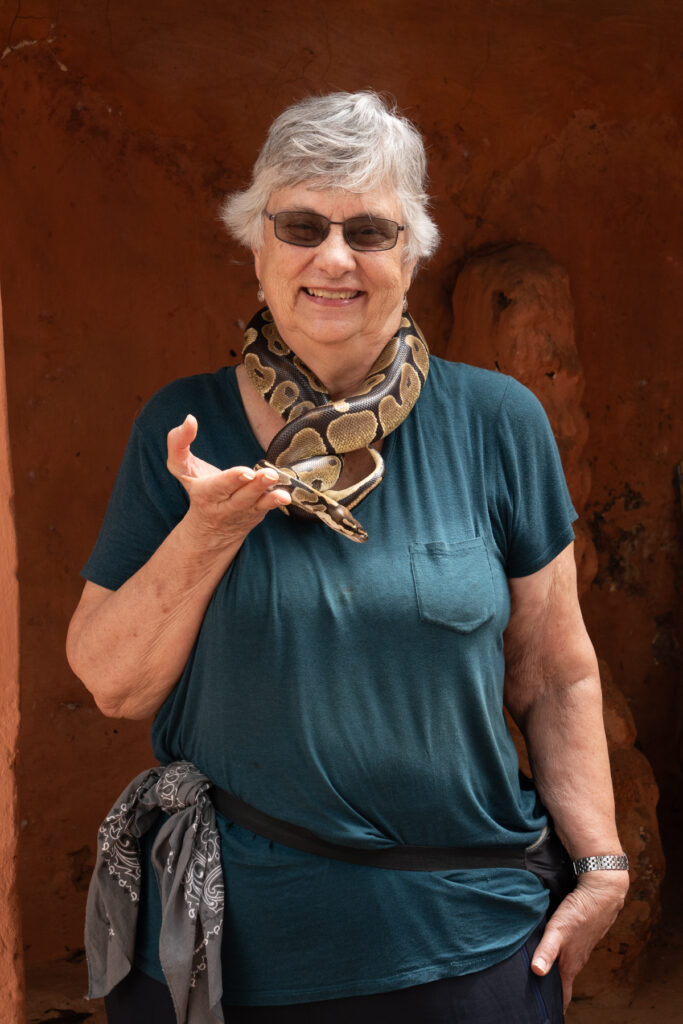
Nancy holding her new friend – a Balls (Royal) Python at the Python Temple in Ouidah (image by Inger Vandyke)
Ouidah’s Dark History of Slavery
Our next stop of the day was the former holding area for slaves before they were sent across the Atlantic in the slave trade. Historians estimate that over two centuries, Ouidah alone exported more than one million Africans before closing its trade in the 1860s. Only one other port in Africa (Luanda, in Central Africa) transported a greater volume of slaves.
It is always extremely confronting to learn about the slave trade in West Africa and understand this era from an African perspective. Even though I have visited these monuments numerous times before, they still move me to tears.
We spent a little time at the slaveholding yard photographing it, the street art nearby and the streets radiating off it.
As we wandered slowly over to the mass grave of slaves who never made it into the trade we were met by a bunch of local kids with one dressed up in fancy dress as a lion. These lovely children danced towards us as we arrived, their amusing antics making light of an otherwise serious morning.
After visiting the mass grave, we then went to see the ‘Memory Tree’, a large Kigelia (or Sausage Tree) that slaves were forced to walk around in circles to forget their ancestors before they were marched out to the Gate of No Return on the beach and loaded onto ships.
Ouidah was an important supplier of slaves to Brazil generally, and to the region of Bahia in particular, even after the trade became increasingly illegal after the early decades of the nineteenth century. After 1840, international diplomacy, law, and enforcement severely restricted Ouidah’s ability to sell African captives. While traders there continued to fill slave ships for a few decades more, the city began to shift toward other commodities—especially palm oil—leading to a decline in Ouidah’s size and importance.
We returned to the delightful café at Alozo for lunch, before driving out to the coast to visit the monument of the Gate of No Return for photos. En route we stopped to photograph some street art adorning the exterior walls of the Python Temple.
Gambada
“The Voodoo Celebration of Love”
That afternoon we drove out to a tiny village to enjoy a ceremony of Gambada, the celebration of the Voodoo love divinity.
Arriving in the small village we instantly noticed some local drummers and musicians who had gathered around a ‘central square’ with a makeshift shrine of Gambada deities at its heart. These white Kaolin-covered deities formed the centrepiece of our afternoon ceremony which saw several local people placed in a trance and then covered in Kaolin to celebrate the voodoo idea of love.
Each of the dancers was adorned in skirts showing the three colours of voodoo (red – fire, black – night, white – light) and each took turns to gyrate their way around the shrine which was, at one point, given customary cigarettes to smoke.
A high point of this ceremony was the procurement of a bowl of burning live embers. One of the dancers heated a machete in these embers and ran it across his tongue. He then took one of the live coals away from the bowl in his teeth!!!
Finally, the ceremony died down as the sun began to set.
We made it back to the hotel just in time to watch the sun go down over the Gulf of Guinea and enjoy another sensational barbecue dinner on the beach in the warm air and sea breeze.
The following morning, we ate breakfast again at a little local café and went to a nearby town to visit a high priestess of twins.
Twins
Twin children are seen as guardians of society in Benin. The countries of Benin and Nigeria have some of the highest rates of multiple births in the world so this morning gave us a chance to learn about the importance of twin cultures in Benin, why they are so revered and we learned about the carrying of twin dolls by parents or siblings whose twin children might have died.
Although it takes place in a small space, this is always a fascinating aspect of the Wild Images Tour in Benin because of the importance of twins in the lives of Beninese people.
We witnessed a ceremonial blessing of twin dolls and then enjoyed some portrait photography with the high priestess and women who were tasked to look after twin dolls in the form of a creche each day.
Egungun
“The living manifestation of the ancestors on earth”
That afternoon we drove out to a village to witness Egungun, the feared masked dancers that represent the ancestors amongst the living.
We arrived while the heat was still strong and after being invited to sit down in the shade of large mango trees, a group of the local women gathered to formally greet us by singing a welcome song to us.
Shortly after this concluded the Egunguns began to arrive from a nearby sacred forest. Each Egungun was accompanied by a guardian wielding a large stick to stop outsiders from touching them. We were to realise afterwards that touching an Egungun was going to be impossible as the ceremony reached a crescendo of drumming, singing and Egunguns running around, terrifying the local kids and community!
This incredible ceremony saw Egunguns racing towards my guests and thwacking each of them with horse-tail ‘whips’, twirling so close to us that one knocked off hats and even knocked the glasses off my head! In between the masked Egunguns would take breaks on a seat next to the village opposite where we sat.
As the ceremony wore on one Egungun took to twirling a large circular skirt around in a spectacular fashion and with so much vigour that he twirled it out of his own hands at one point!
Towards the end we took some portraits of the dancers and also caught some wonderful images of a group of them, backlit by the setting sun, wandering towards us.
Of all the Egungun ceremonies I have seen this one was by far the most photogenic and lively I have witnessed!
Djembe
That evening the owner of the hotel asked if we would like to listen to some Togolese Djembe music on the beach. Of course I said “Yes!” and so we enjoyed our last night in western Benin, on the beach, eating grilled meats and wonderful West African food while listening to the wonderful sounds of Djembe being performed for us.
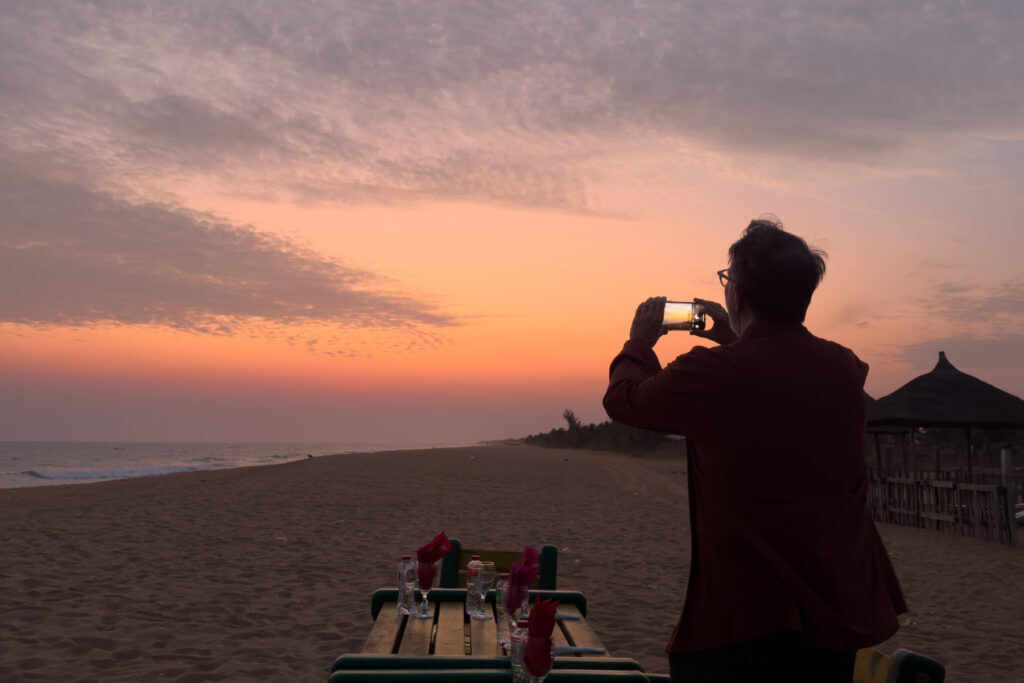
David grabbing a quick iPhone snapshot of the stunning sunset on the beach, shortly before some local live musicians arrived to play Togolese Djembe for us while we ate delicious barbecued food (image by Inger Vandyke)
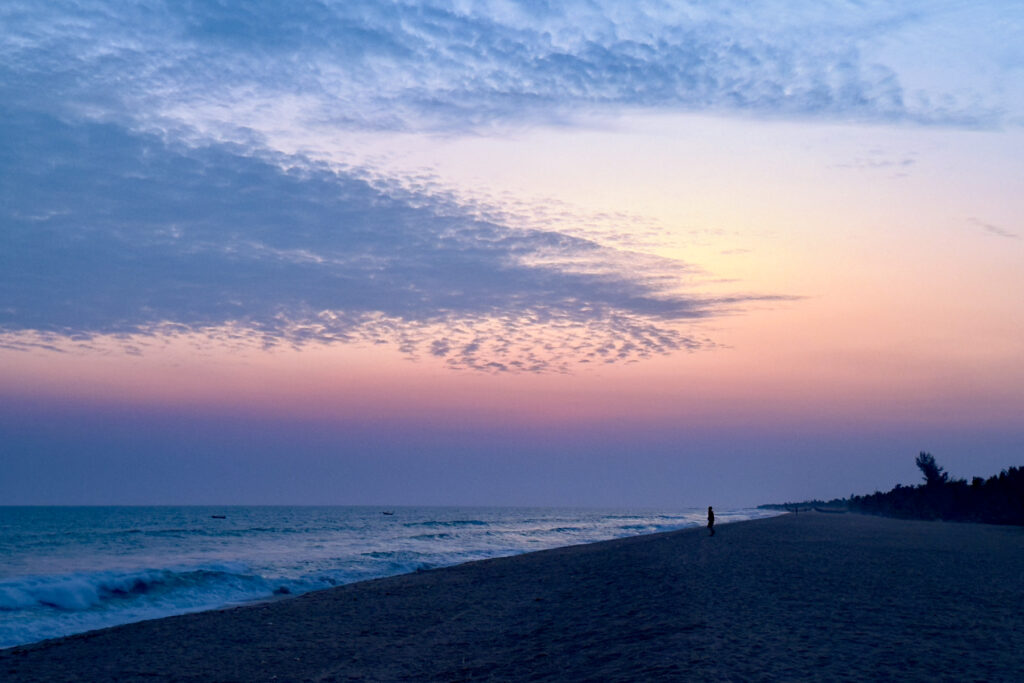
That sunset! Wow! (image by Inger Vandyke)
It was such a wonderful end to our time in western Benin!
Ganvie
The following morning we packed up our bags and drove via Cotonou to the main ferry stop of Ganvie, the ‘Venice of West Africa’, lying in the middle of coastal Lake Nokoue at a confluence of salt and freshwater.
Ganvie is home to the ethnic Tofinu people, who are also described as “The Water People of Benin.” According to historians, during the colonial era when the Europeans made slavery their major trade, a small group of ethnic Tofinu people living outside of what is now Cotonou, took advantage of a different set of circumstances to evade capture by the Portuguese. At the time, the powerful West-African Fon tribe, who had been coastal trading partners of the Portuguese, was hunting and selling other native people to the Portuguese.
The Tofinu people of Ganvie, realizing that the Fon religious practice (the Fon believed that water demons live in the lake) forbade them from raiding any people that dwelt on water, decided to lay the groundwork for Ganvie village by putting up stilt houses in the middle of Lake Nokoue. This clever ploy of raising buildings on the water brought physical impediments, protecting the ancestors of today’s Ganvie village from outside attacks from both the Portuguese and powerful Fon people of the pre-colonial kingdom of Dahomey. Roughly 500 years have passed since the Ganvie people fled to stay on Lake Nokoue. The community, which largely survives from fishing and fish farming, now numbers around 80,000 people.
Visiting Ganvie is always special. While our local team arranged to get two large canoes to take us out to the lake, two of us flew drones over the canoe wharf and local fish market for photos.
It was a relief from the heat to go out onto Lake Nokoue in canoes and during our journey out we stopped to photograph fishermen casting their nets. As we neared the community an amusing young group of Tofinu boys came out in their canoes, singing and dancing to entertain us and earn a little bit of money.
We arrived at our guesthouse, which is run by some friends of mine, on the lake. Just in time to enjoy a lunch of cold beer and fresh lake fish to escape the midday heat. From the restaurant we could see one of two major freshwater points so we enjoyed some ‘people watching’. While we dined the traffic of canoes passing by transported us into the watery world of Ganvie.
After lunch, we got a brief chance to fly drones again to explore Ganvie from the sky.
When the light got better we boarded two canoes and went off on a tour of some of the smaller canals of Ganvie taking photos. During our cruise, we met an assortment of people, some of whom were ok with photos but others weren’t so much.
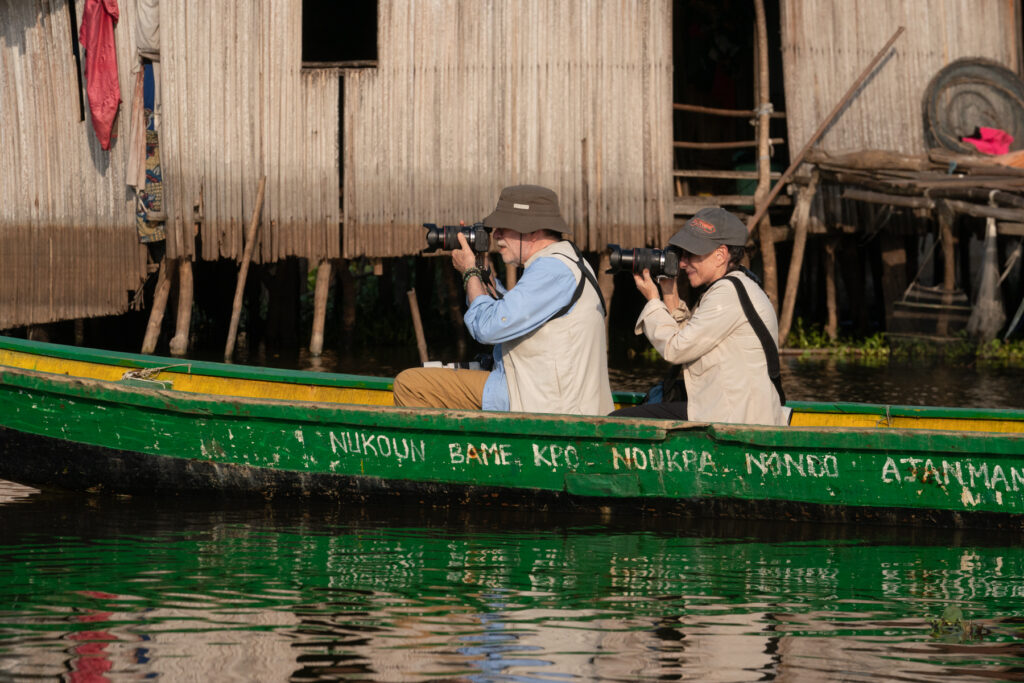
Photographing the wonderful stilt village of Ganvie (image by Inger Vandyke)
It’s odd that, no matter how many times I visit Ganvie, and the associated challenges I have with taking people photos there, many of my favourite images of Benin were shot in this charismatic village on the water.
That night the canoes continued passing by our guest house through the night, often miraculously without any sort of illumination.
Most of us decided to get up at sunrise the next day to take photos and while the dawn initially held more promise in terms of light, a harmattan wind began to waft in which, combined with a lake fog, almost lent Ganvie a mystical air which was also nice for photography.
We also took the chance to take some drone photos but it was a challenge to stay high enough for good images while trying to stay below the mist.
Eventually, we boarded canoes with our luggage and started on our slow journey back to Cotonou. We spent a little time photographing the community and also stopped by the group of young boys paddling around for entertainment, to take photos.
Porto Novo
Finally, we arrived in Cotonou where we boarded buses to continue to Porto Novo, the capital and second largest city in Benin.
Before lunch, we visited the city’s old mosque, one of the most outstanding examples of Afro-Brazilian architecture on the continent and while we mainly walked around outside it taking street photos, I was surprised to see a door open and we were invited to go inside it! Normally the mosque is completely closed off to the public so this rare opportunity was wonderful, even if we could only visit a vestibule to the side of the main prayer hall.
The rest of the day was spent driving to the northeast of Benin, where we stopped in an area of Holi people for a late lunch at a colourful local café. That evening we arrived in Cove in time for a break and dinner at our hotel
Cove is a bustling town close to the border of Benin and Nigeria. As it is in so many African countries, the cultures spill across borders, lending an influence to the people who live there.
Holi People
The next morning we drove out to visit a remote community of Holi people. The Holi are a clan of Yoruba people split between Benin and Nigeria. They are well known for their traditional scarification and tattooing practices, the latter of which was stopped by Christian missionaries and is now a tradition that is only held onto by Holi elders. Facial scarification is still regularly practiced amongst the community’s young people so we went off to explore this beautiful act for a morning.
As always, when we arrived a group of excited Holi children ran out of the village to be our impromptu guides! We then arrived to enjoy a small welcome ceremony where the Holi elders poured a glass of welcome alcohol and also poured libations onto the ground to appease the earth gods.
We were then invited to take portraits and wander around the village for the morning, visiting the local flour mill and homes of these warm people.
Guelede
The Voodoo Celebration of the Feminine Divinity
That afternoon we went off to enjoy our final ceremony of our tour in Benin, that of Guelede, the ceremony devoted to the Feminine Divinity, where all things women and children are celebrated.
We began by visiting the home of a friend of mine, the local mask carver of Guelede masks who fashions these beautiful items from local timbers in the tiny courtyard of his home. We were kindly allowed to take photos there of him, his masks and his family. During our visit, another elderly friend of mine turned up to say hello. It felt good to see everyone again in this incredible corner of Benin!
After we left the mask maker’s house, we went around to where the ceremony was about to begin and while we waited we enjoyed photographing some of the local kids. We took two side photo shoots to photograph some of the Guelede masked dancers away from the ceremony in a portrait situation.
The ceremony began and we were all entertained by several different masked dancers that portrayed aspects of women like cooking and pregnancy, while others were more random including a large orange figure and a stilt dancing dog!
Once the main ceremony had ended we visited a nearby village to photograph some street art while we waited for the grand final act as the sun was setting.
We drove a short distance to a private courtyard where we stopped to photograph a ‘fire-spitting’ Guelede dancer throwing embers to the ground from the fire in a pot atop his mask!
Guelede is always a fascinating and funny ceremony to witness on the Wild Images Benin tours. It is almost always a favourite of our photography guests too!
Abomey
The following morning, we drove from Cove out to Abomey for a morning of sightseeing in the former historical capital of the Dahomey Kingdom.
The Palace of King Agonglo
This city is home to 12 Royal Palaces that were once homes of the Kings of Dahomey. While the main palace was closed to renovation, we visited the lesser palace of King Agonglo, one of the more controversial kings of Dahomey who believed in reinvigorating the slave trade, just as it was dying. On a lighter note, he was also responsible for the start of Abomey cloth weaving so after we visited the palace, we went off to photograph the weavers of this pretty cloth and also buy some from the weavers.
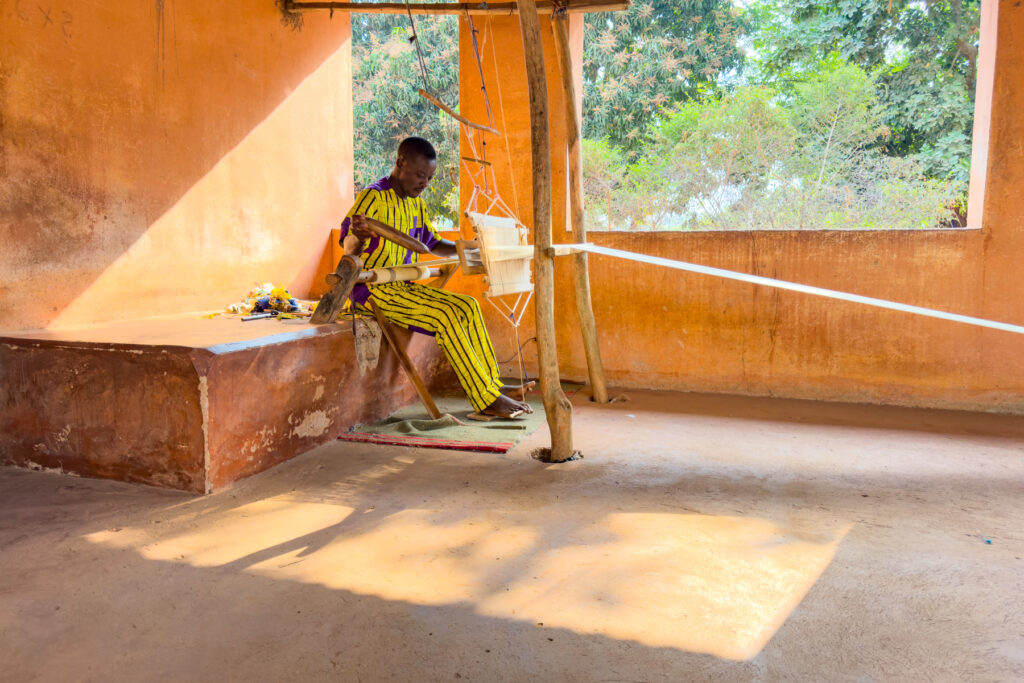
One of the talented weavers of Abomey cloth at the Palace of Agonglo (image by Inger Vandyke)
After we left the palace we drove into the streets of the Afro-Brazilian quarter that led to the palace for some amusing and colourful street photos of local people and the wonderful, crumbling historical facades of the buildings.
The Chameleon Temple
We finally left the streets and drove out into the forest to visit one of the most other-worldly sites we would see in all of Benin, the incredible Chameleon Temple of Abomey.
It appeared at the end of a long dirt road surrounded by forest – two structures, one gigantic temple that was enclosed by highly decorated courtyard walls with a gigantic head of an open-mouthed panther at its entrance.
Opposite that was the Chameleon Temple, one of the best examples of brutalist architecture in Benin, and one which is an active place of worship for Voodoo followers hoping to bring about change. The Chameleon is a symbol of change in Voodoo belief so it is summoned often when people are not happy about one aspect of their lives, to bring about a new beginning.
We were generously allowed to go inside the Chameleon Temple which was quite fascinating! In the end, I got some group images of us all inside the Chameleon’s mouth which was certainly a fun image of it ‘mouth-brooding’ my guests!
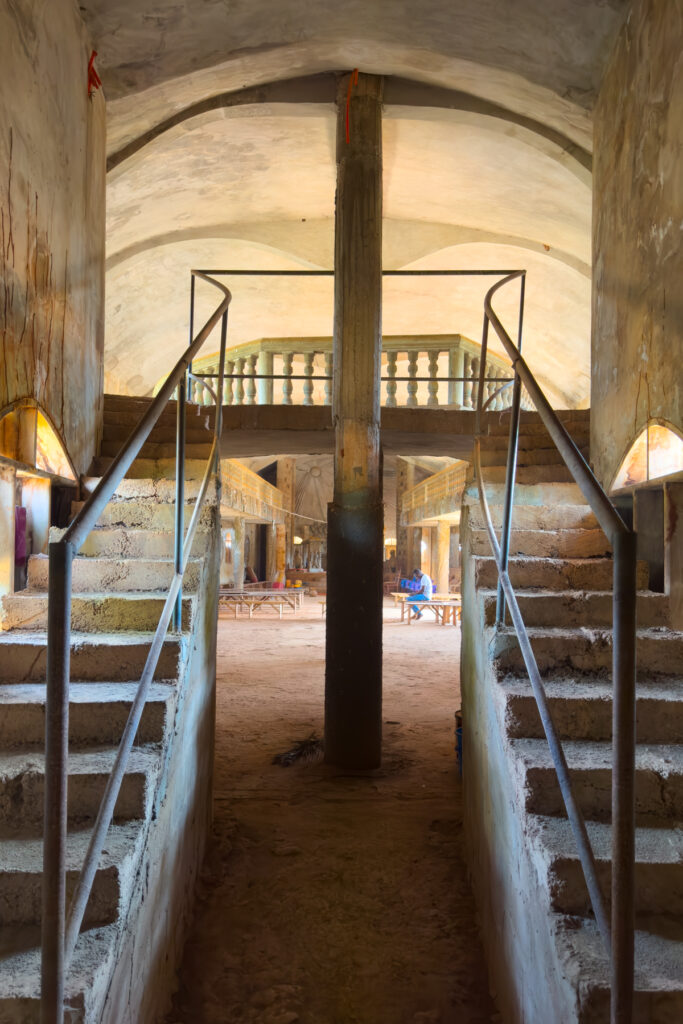
Inside the gigantic chameleon-shaped palace of Abomey (image by Inger Vandyke)
Lunch of Fulani Cheeses and Local Art
From the Chameleon Temple, we went around to one of my favourite local restaurants for lunch. It was here that we enjoyed a simple meal of local Beninese food with some wonderful friend Fulani cheese as a side.
Situated in a lovely grove of large trees that are home to a huge colony of flying foxes, this lovely restaurant in Abomey has a shaded balcony where you dine alfresco. It also often has some wonderful local patchwork made in the style of Abomey’s kings which some of us bought as souvenirs.
After lunch we drove out to a more remote art gallery to view modern pieces by some prominent Beninese artists including abstract paintings from Sess Essoh and some works by Cyprien Tokoudagba. We enjoyed seeing this other side of Benin art and a few of us bought some small souvenirs before we started back on our road trip to Cove, for our final dinner in eastern Benin.
The next morning we packed our bags and left for the remote fishing island close to the border of Benin and Nigeria.
This island is difficult to locate and is accessed by a hand-paddled large canoe through narrow canals lined with freshwater vegetation like hyacinths. It is a community of fisherfolk who established a base on the island for the same reasons the Tofinu ended up creating Ganvie.
We arrived to find ourselves taking a short walk through drying fish nets to the village, stopping to photograph some of the local people making reed mats, tending to their nets and walking to the lake to wash, on the way.
This island’s tiny village is really small in comparison to Ganvie and wandering around here will find you in a labyrinth of simple mud buildings connected by dirt alleyways with side courtyards filled with frying and smoking fish, colourful locals, fishermen mending nets and women tending to animals while caring for their children. It is always a charismatic place to come because the local people are really welcoming and the atmosphere in there is wonderful.
We all reluctantly had to leave as time was ticking for our return to Cotonou.
While we were out at the island, our drivers looked after our luggage in our vehicles and then we drove a long bumpy road back to Porto Novo where we had lunch before arriving in Cotonou to check in at our hotel and take a break before dinner.
Our final dinner in Benin was at our wonderful fish restaurant on the beach!
GHANA
The next day we had a very smooth flight to Accra in Ghana with a stopover for lunch in Lome, Togo.
The Fantasy Coffins of Ghana
Upon our arrival in Accra, we were collected by our wonderful local guide Foster, and driver, Kwami, to begin the Ghanaian section of our tour.
After exchanging cash and grabbing a quick bite to eat, we drove out to the coastal stretch of Accra to visit the Erico Carpentry Shop, one of the most famous carvers of Ghana’s unique ‘Fantasy Coffins’.
Erico belongs to a unique group of men who’ve elevated death into an art form. They build fantasy coffins — okadi adekai in the local Ga dialect — to represent the deceased’s profession, vices or dreams. We spent around an hour chatting to Erico about his creations and viewing some of his more quirky creations including a Lion, a Giant Crab, a US$100 bill, a car and a bottle of Club Beer, complete with funny caskets to hold valuables that were carved in the shape of fruit, a mobile phone and other household items.
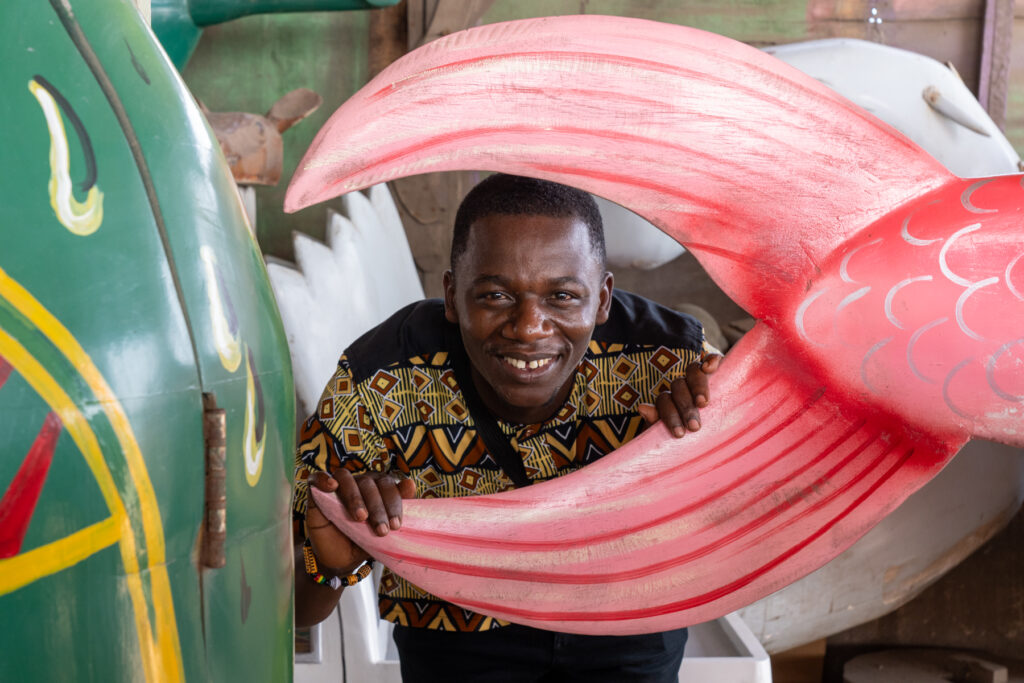
Our guide Foster at the maker of Fantasy Coffins in Ghana (image by Inger Vandyke)
Erico’s work is so famous that he has even been commissioned by a Ghanaian man living in New York and working as a taxi driver, to create a black and gold cab as his coffin for when he passes on!
This was our first fascinating insight into the culture of Ghana and while it was a little challenging for photography, it was still really interesting to see and Erico was a charming host.
The Royal Senchi
A long drive in frustrating Ghana traffic came afterwards. It took us a few hours to reach the city of Akosombo to the north of Accra but when we arrived, the palatial nature of our resort, the Royal Senchi, took our collective breaths away!
Situated on the shore of the Volta River, just a short distance from the massive Lake Volta, the Royal Senchi was a small slice of African Paradise. A stunning resort with pools, wonderful food, Ghanaian-influenced interiors and rooms that are spacious enough to even have baths!
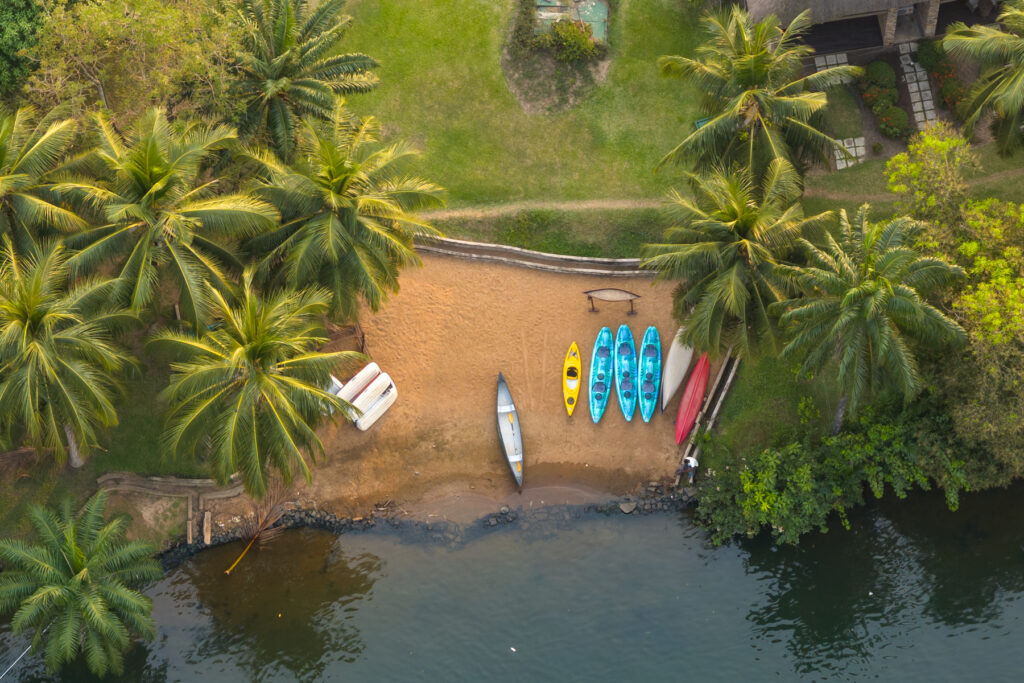
Kayaks waiting for action on a beach at the side of the Volta River in Ghana (image by Inger Vandyke)
After checking in we all enjoyed our first dinner in Ghana in their stunning restaurant.
The following day we drove out to the small town of Somanya, where we spent the entire day immersed in the beautiful culture of Ghana’s Krobo people.
Dipo Initiation Ceremony of Krobo Girls
Our first stop was the palace of King Nene Suorwu IV of the Krobo people. After learning the correct protocols surrounding such a visit we met the king and the women of his family in his private reception room. From here we learned a little about Krobo culture and what we were about to witness that morning.
King Suorwu guided us through a simulated Dipo, the initiation rites of young Krobo girls, which is one of the last major initiation rites of its kind left on earth.
We spent some time photographing and witnessing very young Krobo girls preparing for Dipo, older girls dressed in white going through Dipo and finally girls who had passed through the ceremony who were tasked with assisting younger girls go through the passage. Displays of learning how to do household chores like grinding millet were a part of the ceremony and in between the acts we were taken outside to do portraits of and with the girls in the King’s palace courtyard.
It was a wonderful and colourful education into this fascinating, multi-layered ceremony of Krobo culture!
Towards the end of our time with the Krobo people the women in my group were all gifted a strand of Krobo beads which I’m sure will be treasured by all of us!
After the ceremony concluded we went to enjoy a lunch of Ghanaian food at a local restaurant. It was here we tried ‘Red-red’ a signature dish of Ghana with the main ingredients being cowpeas, tomatoes and red palm oil. Delicious!
Cedi Beads
That afternoon we drove out to a local maker of Krobo beads, the recycled, crushed glass beads that featured heavily in the decoration of the girls at Dipo. It was a lovely chance to buy some of our own beads while we were in the Somanya region.
Krobo beads are widely sold around the world but I always try to encourage my guests to buy direct from the makers if I am in the area with my people. The shop was owned by Mr Nomoda Ebeneze Djaba, one of the most famous creators of Krobo beads.
After our shopping we all returned to our African slice of paradise, the Royal Senchi for an afternoon of relaxing before dinner.
The following morning was essentially filled with the long car drive from Akosombo to Kumasi. On the way we stopped to pick up a packed lunch so we could aim to arrive in Kumasi early enough to enjoy a surprise event for the tour.
Saturday Celebration of an Ashanti Funeral
After checking in at the hotel we went off and spent an afternoon as special guests at a spectacular Ashanti Funeral!
Taking place over three days, Ashanti Funerals begin on Friday and end on Sunday. On the Friday of the funeral, strong men of the family convey the corpse from the morgue often late at night. After washing (often in hot water), they dress the corps neatly either in ‘kente’ or suits. While they wash and dress the corps amid performing rituals, mourners and loved ones console themselves by listening to and dancing to music. This is the wake-keeping. The activities continue until early morning.
At the dawn of Saturday, the chief mourner of the deceased flagged by other family members began to wail and cry. Other mourners join and the whole house gets flooded with tears. If the deceased was a Christian, a pastor of the church congregation will pray. Then the gate will open for all loved ones to pass the deceased and pay their last respects. The family may put money, rings, chains, and handkerchiefs in the coffin. The belief is that the deceased is embarking on another journey to the world of the ancestors and thus may need money to buy stuff on its way. After burial, the funeral begins at 13:00 GMT. Mourners and loved ones usually dress in black or black and red traditional funeral clothing.
Besides that, people also wear the ‘Kente’ cloth, the traditional cloth of the Ashantis.
Sound systems play traditional songs or traditional drumming and dancing groups provide entertainment. The chief mourner and the extended family members sit at the funeral site. Usually, the funeral grounds are at a central location of a town. Friends and other loved ones who have travelled from far and near greet the mourners.
Cash donations called ‘nsawa’ are given to the family of the deceased to defray the cost of the funerals. Other donations such as bottled or sachet water, drinks, cloth or farm animals may also be donated. In return for the donations, the donors get food and drinks.
On Sunday the funeral party will dress in black and white to attend a thanksgiving service for the deceased.
This incredibly loud and formal event of Ghanaian Ashanti people dressed in mostly red and black was an amazing and unexpected highlight of our trip!
It was extremely kind of the families in attendance to allow us to visit and take photos!
Just as we were leaving we stopped to take some street photos of people and local kids before we returned to our hotel for dinner.
A Private Audience with King Lutin Sraman II of the Ashanti People
The following morning, we were honoured to be granted a private audience with King (Nana) Lutin Sraman II of the Aduane clan of the Ashanti people in Ghana. This was meant to be our first experience with meeting Ashanti people (the funeral the previous day was a spontaneous surprise) and we drove to his palace in Kumasi where our reception took place.
As we entered the palace we noticed some unusual motifs painted on the entrance walls. They were of dogs carrying fire in their mouths, symbols of the totems of the King’s clan. Legend dictates that when the Aduane Ashantis migrated to Kumasi from Dekyera, they had no fire so they couldn’t cook or stay warm. One night at their camps a dog arrived carrying fire so the Aduane thought he was a god and they made the dog their clan totem.
Amidst a starting ceremony of young Ashanti men and women wearing Kente, carrying wooden swords and gold ornaments, our ceremony with the King began. We were all following a strict protocol that surrounds these royal visits which included special speeches given by the King and accepting his gifts of handwoven Kente.
Throughout the morning we watched King Sraman and his chiefs arrive in the shade of umbrellas wearing the normal attire of royal life for the Ashanti people. An Ashanti chief walked around blessing the throne and seats of the chiefs with a burning pot of Ghanaian frankincense to mark the arrival of royalty.
We then watched as the royal party changed into the attire of funerals and finally the clothes of war, in between celebrations performed by young Ashanti people to the loud traditional banging of Ashanti drums. It was all colourful and fascinating to witness!
At the end, we were invited to the King’s formal office for a final farewell and the handover of our gifts to the Ashanti community.
Adinkra
There are two traditional cloths made by the Ashanti people of Ghana. The first is Kente which is famous throughout the world for it’s hand-woven quality of colours of red, green and yellow.
The second is Adinkra. Adinkra is a printed fabric with paint that is created from the bark of a tree onto plain coloured, woven Kente cloth.
We visited a factory to watch how the paint is made and we saw the tree bark being pounded and then cooked to create the black paint. All of this was taking place in a small courtyard filled with the homeliness of a Ghanaian family compound. At its heart was a handsome Ashanti woman in her eighties, who proudly showed us how she cooked the bark to make the Adinkra paint before allowing us to take some portrait photos of her.
After we visited the paint-making area we went outside to choose our own Adinkra stamps and each of us got to create our own Adinkra cloth using a complimentary strip of cloth and our chosen symbols. This was followed by some souvenir shopping and our return to our hotel in time for dinner.
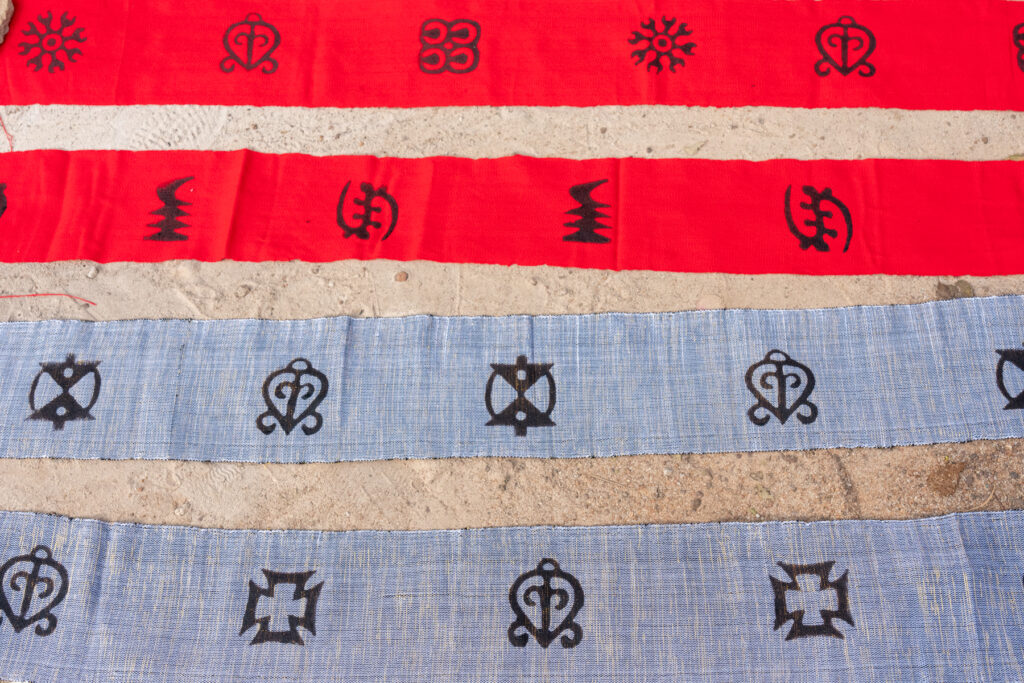
Our Wild Images group got to create their own Adinkra cloth during our 2024 tour. Here their creations lay drying in the sun (image by Inger Vandyke)
The next morning we began our journey back to southern Ghana by driving from Kumasi to the Cape Coast where we arrived in time to enjoy a lunch at a local resort.
The Posuban Shrines of the Asafo People
We spent the afternoon visiting the Cape Coast fishing community taking photos and then also two of the twelve Posuban Shrines of the Asafo military arm of Ghana’s Akan people.
These shrines are the work of Asafo companies, the patrilineal military units that are a feature of most Akan societies. Asafo companies are traditionally responsible for the defence of their town, but these days they are perhaps more significant for their ceremonial function and their activity and influence in the arts and local politics. Most towns in the region have between five and 12 rival Asafo companies, each identified by a number, name and location. Generally, the lower the number of the unit, the earlier it was established, and the more influential it is on the chieftaincy.
While we could only visit the outside of the first shrine, we were invited to go inside in the second one. Sadly, most of the items of worship had been removed to a safer place due to a lack of security leading to theft at these shrines. Still, it was interesting to visit and go inside these colourful places, and learn about the Asafo companies while we took photos.
Elmina (St George’s) Castle
From Cape Coast we drove out to the historical city of Elmina, a picturesque fishing town along Ghana’s coast, not far from Cape Coast. It is home to one of Ghana’s biggest attractions, St George’s Castle.
St George’s Castle, a Unesco heritage site, was built as a trading post by the Portuguese in 1482, and captured by the Dutch in 1637. It was expanded when slaves replaced gold as the major object of commerce, with storerooms converted into dungeons. The informative tour (included in the entry fee) takes you to the grim dungeons, punishment cells, Door of No Return and the turret room where the British imprisoned the Ashanti king, Prempeh I, for four years.
Elmina Castle was the first trading post built on the Gulf of Guinea, so it is the oldest European building in existence in sub-Saharan Africa. Elmina is also a picturesque fishing town along Ghana’s coast, not far from Cape Coast. It is home to one of Ghana’s biggest attractions, St George’s Castle. Built by the Portuguese in 1482, it was captured by the Dutch 150 years later and became the headquarters of their West Indies Company for the following 250 years.
Gold exports were soon replaced by slaves and the tours through the dungeons will give you a good idea of how gruesome a trade it was. The Castle houses a small museum and guided tours are available. The stark beauty of the white-washed Castle walls contrasts deeply with the dark history of this place, one of the main centres of the trans-Atlantic slave trade.
We took a guided tour through the dungeons, military and officials’ rooms and we also visited the church inside the castle. It was all very confronting and sad – a testimony to history that none of us should ever allow to be repeated.
As the sun was setting we split into two groups to go outside and take photos in the golden glow of the late afternoon. We enjoyed some drone and street photography around Elmina’s harbour before driving a short distance to check into our beachside resort in time for dinner.
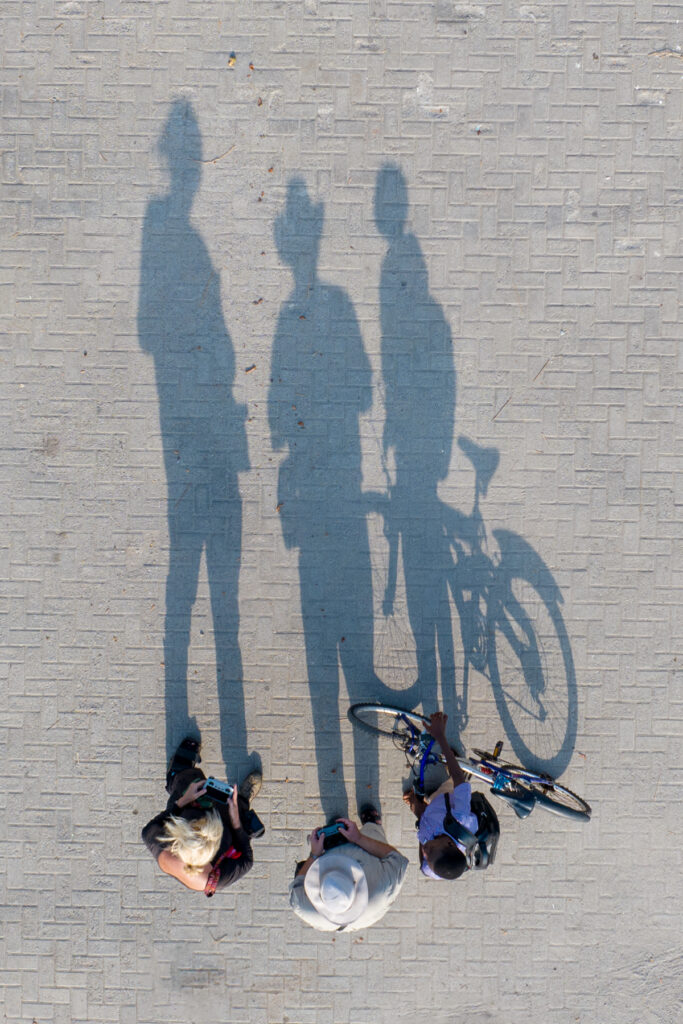
The drone pilots and their shadows on tour in Ghana (image by Inger Vandyke)
I decided it was so beautiful for photography at Elmina that I invited anyone interested to join me for a morning of sunrise photography around the harbour.
Our Final Sunrise in Ghana
We once again left for the bustle of fishing boats in the tiny port with its ramshackle buildings, colourful walls, wooden fishing boats and net mending. The drone flyers were treated to sunrise over the castle and I managed to get out and fly over Elmina’s salt works.
The street photographers enjoyed some colourful scenes of Elmina’s fishing community under the blush of our final morning in Ghana.
We returned to our hotel to join the rest of our group members for a later breakfast before we packed up and drove back to Accra.
That afternoon we enjoyed a wonderful rest at the stunning Labadi Bay Beach Resort before our tour ended in the airport of Accra.
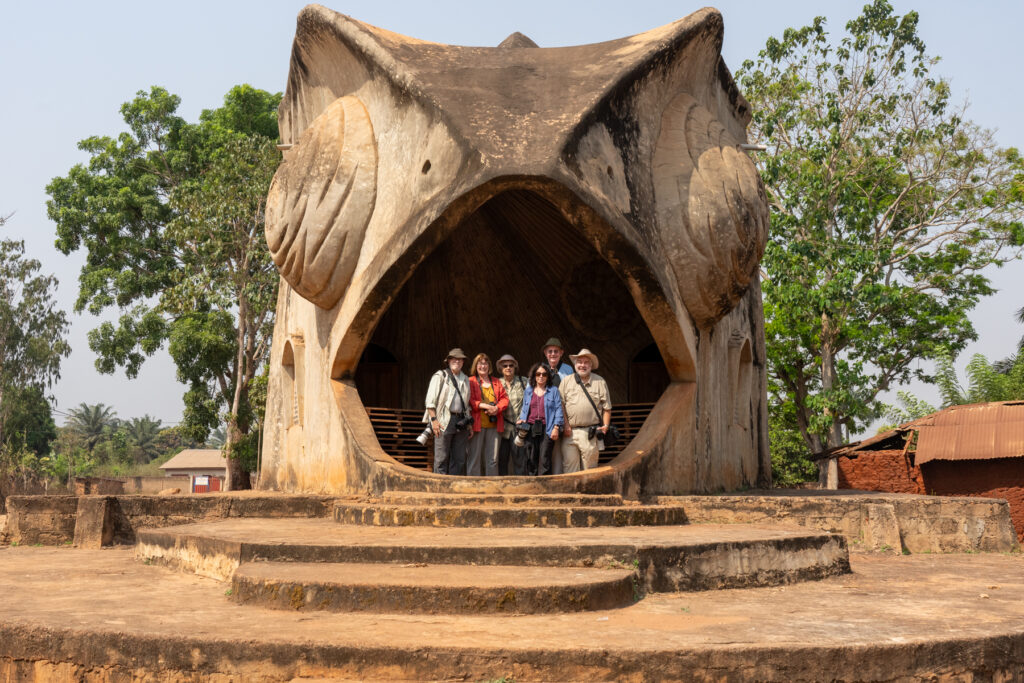
Our 2024 Wild Images group inside the gigantic mouth of the Chameleon at the Chameleon Temple in Abomey (image by Inger Vandyke)







































































































































